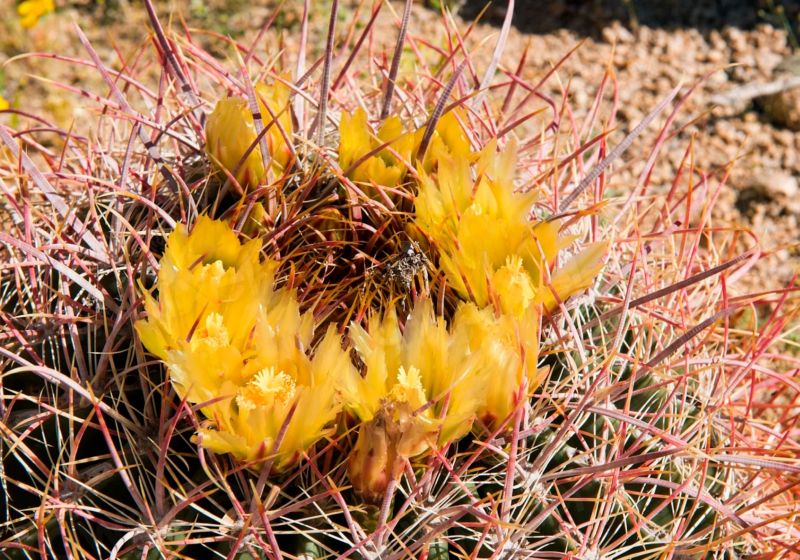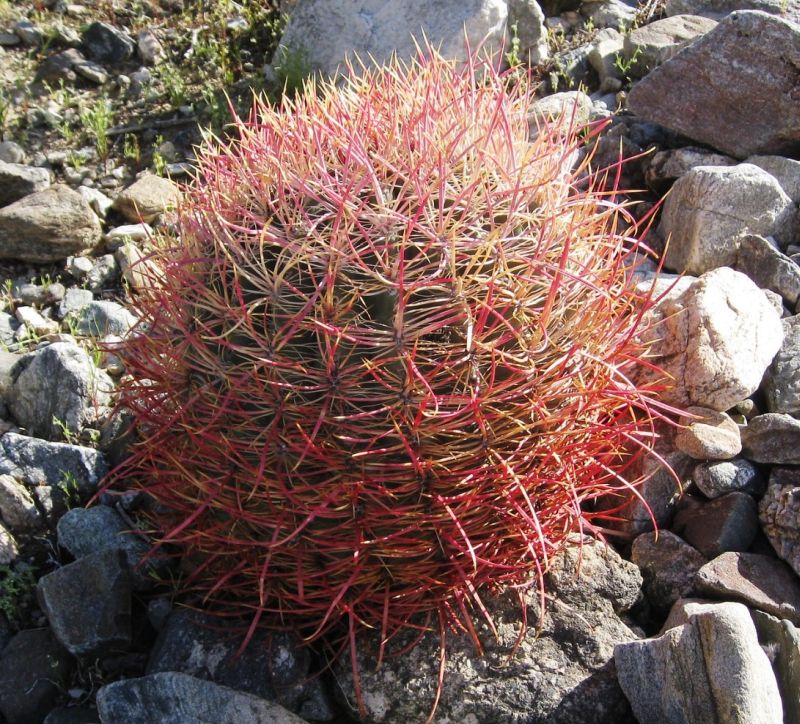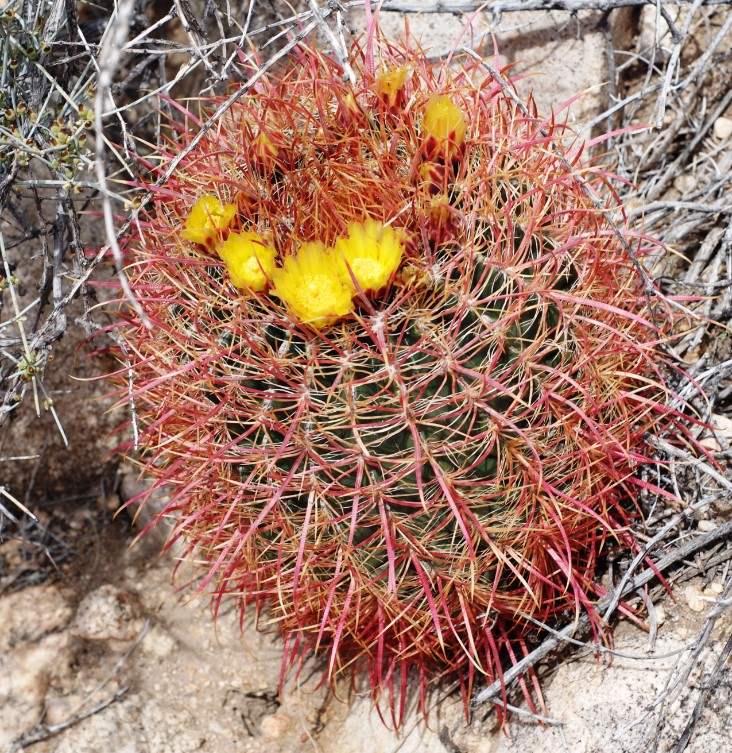Description: George Engelmann named the barrel-cactus variation Ferocactus cylindraceus in 1853. This unusual cactus poses a threat to plant collectors due to its exquisite features and sculptural form.
Other Names: It has several common names, including California Barrel cactus, Cliff Barrel cactus, Compass barrel cactus, Compass cactus, Desert barrel cactus, Golden-spined barrel cactus, Le Conte Barrel cactus, and Spiny barrel cactus.
Habitat: Ferocactus cylindraceus is solitary, rarely branching. It grows in creosote bush scrub and Joshua tree woodland on gravelly, rocky, or sandy soils.
Family: Cactaceae,
Shape: Ferocactus cylindraceus is typically cylindrical or spherical, with some earlier specimens producing 2-meter (6.6 feet) tall columns.
Stems. The stem is globose to cylindrical, 3 meters (9.8 feet) high, and 50 cm (20 inches) in diameter.
Ribs: About 20–30, usually tuberculate, sometimes undulate, with transverse creases.
Spines are variable, white, red, yellow, or brown, and somewhat flexible.
Central spines 4–7, some round in cross-section but others flattened, sometimes curved or hooked, 5–15 cm (2–5.9 inches) long.
Radial spines (15–25) are hair-like to stout, often intergrading with the centrals.
Flowers: This cactus bears funnelform, yellow but sometimes tinged with red flowers, 3–6 cm (1.2–2.4 inches) long, 4-6 cm (1.6–2.4 inches) in diameter.
Fruits: The fruit is globose, yellow, to 3 cm (1.2 inches) long, fleshy, and dehiscing by basal pores.
Fruit Type: Berry
Elevation: From 65–1,550 meters in elevation.
Flower Bloom: The flower blooms in spring and summer, i.e., in March, April, May, and June.
Distribution: Ferocactus cylindraceus is found in southern California (eastern Mojave Desert and western Sonoran Desert Ecoregions), Nevada, Utah, and Arizona, and Baja California and Sonora, Mexico.
Subspecies: Three subspecies of Ferocactus cylindraceus are recognized.
-
Subspecies Cylindraceus may grow to 3 meters (9.8 feet) high, have twisted yellow, red, or brown central spines, and have 15–25 radials. It occurs in southern California, southwestern Arizona, northern Baja California, and northwestern Sonora.
-
Subspecies lecontei have untwisted central spines that are never hooked and are often closely pressed to the stem. It occurs in southern Nevada, southwestern Utah, southern California, and much of Arizona.
-
Subspecies tortulispinus has much shorter stems, often with flattened stem tips, and very twisted gray spines; it is restricted to northern Baja California.
Cultivation and Propagation: Cultivation and Propagation: These are summer-growing, easy-to-grow plants that bloom when they reach a diameter of only 15–18 cm. It is slow to start the speed when the plants reach approximately five cm in diameter. Repotting is preferably in the spring, in case roots become cramped. However, repotted at any time to give fresh soil. Don’t give it water after repotting for at least one week. It can tolerate moderate shade, but growing in shade should be gradually hardened off before placing it in full sun, which will result in severe scorching if moved too suddenly from shade into the sun. Outside, they need bright exposure, full sun, or half shade in the summer if the location is extremely hot or bright.
Soil: Clay, pumice, lava grit, and minimal amounts of peat or leaf mold are among the rich, well-drained soil types that they work well in. During the summer, apply a high-potassium fertilizer.
Watering: During the summer growth cycle, water the plant frequently, but do not overwater and allow the soil to dry out between waterings. You should also avoid wetting the plant’s body while it is exposed to sunlight, as this can cause sunburn, which can result in scars, fungal infections, and even death. In the winter, keep the plant fairly dry. Water the roots no more than once. This plant needs a time of cool rest in winter to produce an abundance of blossoms; light frost protection is required for safe cultivation; however, it may tolerate occasional mild frost.
Pests and diseases: Keep an eye out for mealybug, scale, and spider mite infestations.
Usage: The Native Americans used to extract water from barrel cactus to cut off the top, create a depression in the surface resembling a bowl, and then squeeze the surrounding tissue until water filled the depression.
Bibliography: Major references and further lectures, Edward F. Anderson, “The Cactus Family,” Timber Press, 2001
Synonyms: Viridescens (var.) cylindraceus Engelmann 1852, E. cylindraceus (Engelmann) Engelmann 1856 Echinocactus acanthodes Lemaire 1839, rejected name (see Taylor 1979b); Ferocactus acanthodes (Lemaire) Britton & Rose 1922, rejected name Echinocactus lecontei Engelmann 1856, Ferocactus lecontei (Engelmann) Britton & Rose 1922, F. acanthodes var. lecontei (Engelmann) G. E. Lindsay 1955, F. cylindraceus var. lecontei (Engelmann) Bravo 1980, F. cylindraceus subsp. lecontei (Engelmann) N. P. Taylor, 1998 Ferocactus rostii Britton & Rose 1922, F. acanthodes var. rost (Britton & Rose); W. T. Marshall & Bock 1941 Echinocactus hertrichii Weinberg 1929 Ferocactus tortulispinus H. E. Gates 1933, F. acanthodes var. tortulispinus (H. E. Gates); G. E. Lindsay 1955, F. cylindraceus var. tortulispinus (H. E. Gates) Bravo 1980, F. cylindraceus subsp. tortulispinus (H. E. Gates); N. P. Taylor 1998.
Read More: Ferocactus emoryi (Engelmann) Orcutt 1926










